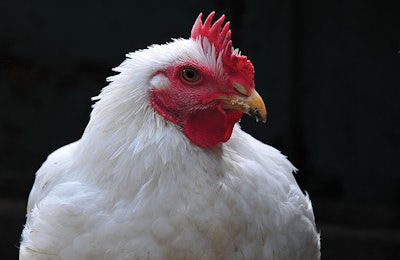
Commercial broiler birds may not spend enough time in the dark. At least four hours of darkness a day should be provided for the best performance.
As part of the virtual Poultry Welfare Certification Course held by the Pennsylvania State University’s College of Agricultural Sciences in late 2020, Dr. Karen Schwean-Lardner, associate professor in the Department of Animal and Poultry Science at the University of Saskatchewan spoke about research surrounding the relationship between daylength and bird welfare.
She said the conventional thinking in broiler production is that maximizing day length maximizes time birds can eating and therefore grow. New research shows birds need daily, sustained darkness to be healthy and grow.

Dr. Karen Schwean-Lardner, University of Saskatchewan (Courtesy Karen Schwean-Lardner)
Performance
Schwean-Lardner said the research is based on testing the theory that more light equals more weight gain. To test it, multiple trials were conducted with different lighting programs comprising of:
- 14 hours of light, 10 hours of darkness (14L:10D)
- 17 hours of light, 7 hours of darkness (17L:7D)
- 20 hours of light, 4 hours of darkness (20L:4D)
- 23 hours of light, 1 hour of darkness (23L:1D)
She analyzed the results of a study comparing performance in terms of total body weight. That trail showed the 23L:1D program was the least effect in terms of weight gain. At 32 days of age there was a slight difference in average broiler body weight between those programs but at days 39 and 49 the difference was more pronounced.
That same trial found adding darkness shifts the time when birds gain weight to later in their lives. This is important because if birds gain weight too quickly too early in their lives, they put undue stress on their metabolic and skeletal system. Darkness helps fortify the birds before their period of the greatest weight gain and allows them to gain more weight.

The best broiler body weights are correlated with at least 4 hours of darkness every day. (British Poultry Science)
Health
The same study examined numerous health conditions that affect bird health, welfare and ultimately performance. In general, these studies concluded more darkness meant less health problems.
Schwean-Lardner said birds living in programs with more darkness showed lower level of mortality and culls than those living with less darkness. The same was true for potentially costly skeletal and metabolic problems.
Those studies also examined gait scores – an indicator of how well a bird can move around which is indicative of health, welfare and its potential to access feed and water – and found birds with more darkness had higher gait scores.

Birds need to sleep and rest in sustained dark periods for the best health and welfare. (Kharkhan_Oleg | iStock.com)
Behavior
Finally, infrared video monitoring technology was used to track the movement of a flock of birds during a 24-hour period, again using four different daylength lighting programs.
Schwean-Lardner said percentage of time walking was the chosen metric for the monitoring because walking the key to movement around the house, ability to access the feeders and drinkers and an indicator of bird health. Again, birds living in the 23L:1D program walked around the least. The same was true when researchers tracked the amount of time the birds were feeding.
Moreover, the studies showed darkness increases activity and behavioral expression in broilers. Birds living with 23 or 24 hours of light a day saw a reduction in activities expressing comfort, a desire to explore, playfulness, a desire to exercise and a desire to eat.
Why darkness matters
Birds need to sleep and rest in sustained dark periods for the best health and welfare. Like other terrestrial animals, they live with diurnal rhythms and produce melatonin in their brains. Melatonin is a neurotransmitter that’s associated with sleep and plays a role in immune function as well as growth and reproductive hormones.
When birds don’t have a period simulating night, they don’t produce melatonin as well as those with a dark period and they don’t establish a normal sleep cycle. Schwean-Lardner said researchers wondered if this could be linked to sleep deprivation in the birds. In humans, its known that lack of sleep causes immune system problems, lethargy, lower stimulus response and lower ability to regenerate tissue. Birds living in a 23L:1D house show similar symptoms. It is known that birds can sleep in a light environment, but when they do sleep they are experiencing sleep fragmentation, or waking up constantly, and not getting quality sleep.
The researchers conducted their own experiment examining behavioral rhythms in flocks under the four lighting programs. They found birds living with longer dark periods exhibited more consistent, rhythmic behaviors – and produced melatonin at more consistent times – than those living with short dark periods.
Conclusions
Therefore, the researchers concluded that continuous lighting in broiler production is not acceptable for broiler production. The animal suffers from poorer health and welfare outcomes and the grower suffers from lower market body weights.
Birds with at least four hours of darkness establish circadian rhythms, have higher feed efficiency, lower mortality, and morbidity than those in near constant light, are less lethargic, get more exercise and do not grow as early in their life cycle. Heat production inside a broiler house also decreases by 20% during the dark period independent of the animal’s feed intake.
Implications for growers
Schwean-Lardner said this topic can be divisive because every situation differs and every farm differs. However, the data indicates the birds need at least four hours of uninterrupted darkness – preferably with a gradual transition from light to darkness and vice versa – for the birds to perform their best.
For growers, darkness can be a powerful management tool. She said if feed costs are up and higher feed efficiency is needed, more darkness can help. Adding up to 10 hours of darkness can have a substantial benefit.
Those dealing with higher levels of culls, Sudden Death Syndrome, ascites or skeletal disorders, adding more darkness can also bring substantial benefits.
“We know that darkness can allow diurnal or circadian patterns, it improves sleep and alters behavior. And again, it can be tailored to meet particular farms, but there should be a minimum of the amount of darkness,” Schwean-Lardner said. “In our Canadian codes of practice. We have mandated that four hours of darkness be used in commercial productions from a minimum of seven days of age.”
How to properly light a poultry house:
www.WATTPoultry.com/articles/41266



.jpg?auto=format%2Ccompress&fit=crop&h=167&q=70&w=250)












